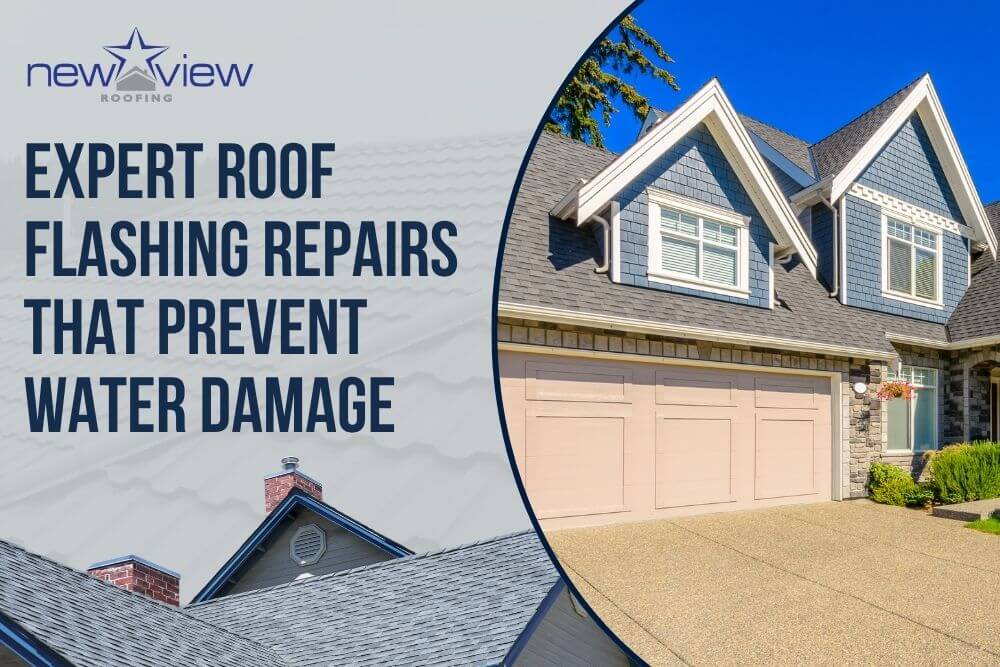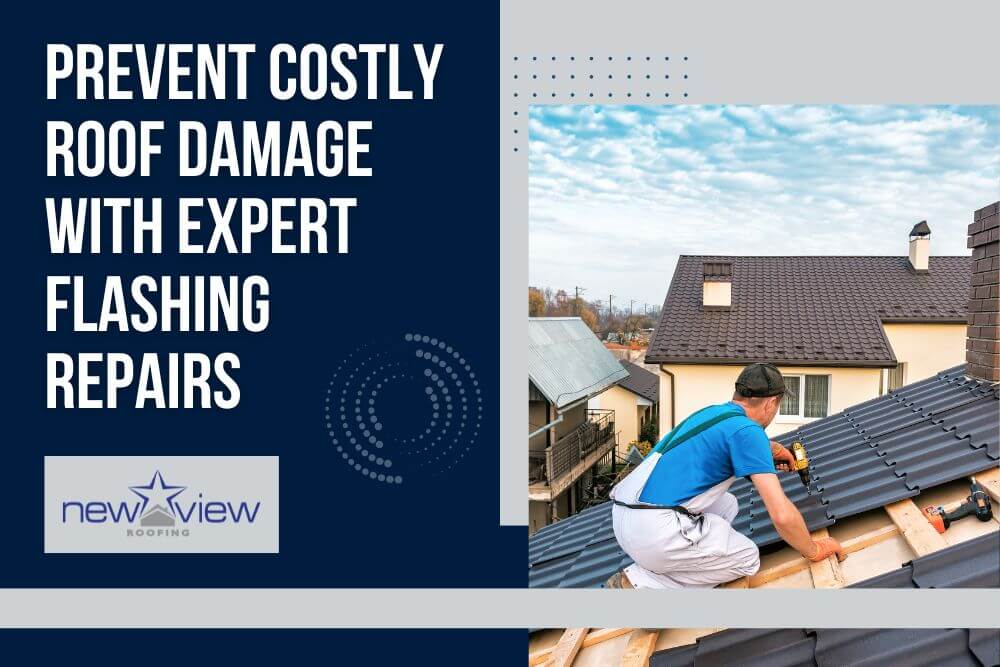Luckily, New View Roofing is an expert when it comes to the storm damage repair process. We will be with you every step of the way, from the first inspection after the storm through the completion of your roof. Our goal with every repair job isn’t getting quick cash like those storm chasing roofers. At New View Roofing, we aim to earn your trust and create a lifelong client who will refer other clients to us through word of mouth.
When you hire us, you can enjoy a hassle-free process from start to finish during the roof restoration process.
Roof Flashing Guide
There’s a lot that goes into storm repair. This guide details roof flashing repair. From roof flashing repair costs to how they work and more, you will understand why repairing flashing is so important and why you should only choose a roof flashing repair specialist to complete the flashing restoration on your roof.
Roof Flashing Repair Specialist
Hailstones fall thousands of feet from the sky and can easily dent, bruise, crack or smash through roofing components and siding. It can be difficult for the untrained eye to detect hail damage. Our trained professionals will carefully check for any signs of hail damage after a storm event.
What is Roof Flashing?
Roof flashing is material used to prevent water penetration and leaks around joints and transitions on a roof. It could be made from a variety of different materials, but it typically involves the installation of thin protective strips. Usually, these thin protective strips are made from metal, such as aluminum, copper or galvanized steel. However, other materials, such as PVC, may also make good flashing.
Roof flashing has a very serious purpose. It creates a water-tight barrier and redirects water away from vulnerable areas where your roof is susceptible to leaks. Usually, these areas include places like intersections between different roof planes, valleys, chimneys, skylights, vents or other penetrations or interruptions on the roof’s surface.
Flashing is shaped or customized to fit specific areas on your roof. Usually, experts install it by overlapping the roof material, such as shingles or tiles, and then sealing the joints using caulk, roofing cement or other weatherproofing materials. Flashing serves as a protective layer that prevents water from getting into the underlying roof structure.
When roof flashing is installed properly, it helps maintain your roof’s integrity by keeping destructive moisture and wetness out. It also prevents water damage to your home and prolongs your roofing system’s lifespan. It’s an essential part of ensuring that your roof remains water-tight and resistant to leaks.
Why Does Roof Flashing Need to Be in Excellent Condition?
The flashing on your roof needs to be in excellent condition for several important reasons, including water protection, structural integrity and energy efficiency. It also needs to remain in excellent condition to help preserve your roofing materials.
- Water protection. Flashing’s primary purpose is to provide a waterproof barrier and prevent water from penetrating vulnerable areas of your roof. If the flashing is damaged, deteriorated or improperly installed, your roof may leak or sustain water damage. If you’re flashing is functioning properly, it helps channel water away from critical areas and protects your roof’s structure, your interior spaces and everything inside your building.
- Structural integrity. If your flashing is well maintained, it helps protect your roof’s overall structural integrity. It does this by preventing water intrusion and helping safeguard the underlying roof materials, such as decking, rafters and insulation. These things can deteriorate quickly if they’re exposed to moisture, so good flashing helps maintain your roof’s strength and durability over time.
- Energy efficiency. Damaged or inadequate flashing impacts your home or business’ energy efficiency. If water seeps into your roofing system, it generally leads to moisture accumulation, mold growth and compromised insulation. Each of these issues can increase energy consumption and reduce your HVAC system’s effectiveness.
- Lifespan of roofing materials. Properly installed and maintained flashing can extend your roof’s lifespan. By redirecting water away from critical areas, flashing helps protect your entire roofing system from premature deterioration that can be caused by water damage, rot or corrosion. When your flashing is working properly, it can save you from expensive roof repairs.
Don't Wait Until Damage Gets Worse.
Common Problems With Roof Flashing

When your flashing is installed properly, you typically don’t need to worry about it unless it becomes damage by a storm or other event. However, there are a few issues to be aware of. You can keep a lookout for these problems on your own, but we recommend that all homeowners get an annual roof inspection. Our experienced team can identify problem areas before they can do serious damage.:
- Metal flashing, such as that made from aluminum or galvanized steel, can corrode when it’s overexposed to the elements. However, if metal flashing is coated properly, it can resist the elements very well. It’s important to note, though, that corrosion weakens flashing and makes it prone to leaks and failure. That’s why it’s important to make sure your roofer uses only high-quality materials on your roof and that you get an annual roof
- Flashing materials can sometimes crack, break or develop gaps due to aging, expansion and contraction from temperature variations, and physical damage. These openings in the flashing provide pathways for water to get into your roof system.
- Improper installation. If flashing is installed improperly, or when installers use low quality materials, your flashing may be inadequate to protect your roof from water intrusion. Additionally, flashing that isn’t fastened securely or properly sealed may not be very effective at preventing water from getting in.
- Separation and lifting. Over time, flashing can separate or lift away from the roof surface thanks to wind, vibrations or poor installation. When it lifts away from your roof, it can’t effectively redirect water, which leads to leaks.
- With exposure to weather and time, flashing materials can begin to deteriorate. Rubber and plastic flashing may become brittle, crack or degrade under UV radiation, which leaves vulnerable areas exposed to water incursion.
If you notice any of these signs or issues, you should call New View Roofing right away. We can send an inspector to your location to determine the extent of the damage and provide you with solutions to stop further damage.
How to Tell if There’s Something Wrong With Your Roof Flashing
In some cases, it’s possible to tell whether there’s something wrong with your roof flashing without climbing up on your roof and inspecting it yourself. Additionally, you can always get a free roof inspection from New View Roofing; we can send an expert to your home or business to look for issues.
Some of the signs that there’s something wrong with your roof flashing include:
- Water stains or leaks. If you’ve seen water stains or visible leaks inside your home, along walls or ceilings or in the attic, that may indicate a problem with your flashing.
- Dampness or mold. Dampness or mold growth in your attic or in the upper levels of your building can be a sign that your flashing is compromised or that water has infiltrated your roof.
- Visible damage. If you can see that the flashing on your roof has been damaged, you should call a roofing expert immediately. You need someone who can climb on your roof and evaluate the extent of the damage, as well as look for collateral damage, and let you know what needs to be done to repair the issue and prevent further damage.
- Peeling paint or stained exterior. Sometimes a sign of water seeping in through faulty flashing is peeling paint or stained exterior. Look for paint on exterior walls near the roof line and determine whether it’s peeling, bulging or stained. Likewise, if your siding is stained, it could be a sign that the flashing is damaged and it’s allowing water to leak through in the wrong places.
Roof Flashing Repair Costs
If the roof flashing repair costs have you feeling uneasy, remember this: we’re not storm chasers. You may have heard horror stories from a transient roofing company citing labor, shingle and roof flashing repair costs so high that you will surely just need a new roof.
Unfortunately, those scare tactics often work to scam people with storm damage into prematurely purchasing a new roof from a company that will leave them out in the cold after they’ve gotten paid.
While it’s true that sometimes, after a storm, it is best to purchase a new roof, it isn’t always the case. And the shingle replacement cost and roof flashing cost from a repair job is often quite affordable.
Our experienced roofing contractors will be on-site quickly to identify the damage and work with your insurance adjuster directly.
Unexpected Roof Flashing Repair Costs
Although you can often budget for roof flashing repair costs, there are a variety of times when you can’t. Sometimes the unexpected happens, and you either need to have the flashing repaired or replaced or you will end up with a leaky roof.
Wind Damage Can Lead To Roof Flashing Repair Costs
High winds can lift and break the adhesive seal underneath shingles. If wind-blown debris enters the flashing layer during the storm and prevents the flashing from re-sealing, then the flashing requires repair. We provide wind damage inspections to identify these problems before they allow water intrusion.
Fallen Debris Can Lead To Roof Flashing Repair Costs
Tree branches and other large objects picked up in a storm can fall on your roof, causing destructive impact damage. One of our certified roofing contractors will remove the debris and make a plan to restore your roof.
Book A Free Inspection To Learn the Roof Flashing Repair Costs Needed For Your Roof
At the end of the day, roof flashing is a professional roofing material, so we recommend a professional to diagnose if there’s a problem. The good news is you never have to pay for a roof inspection with us. Whether your roof is old or endured a recent storm, we’ll inspect every aspect of your roofing system and let you know if repairs or a replacement is necessary (if any) and provid photo evidence to back it up. Schedule an inspection on our website or call (469) 716-5426.
Free Roof Inspection
Regular roof maintenance can extend the lifespan of your roof and save money on a premature replacement. As a trusted Dallas roof repair contractor, New View Roofing will give you peace of mind that your home is protected.

